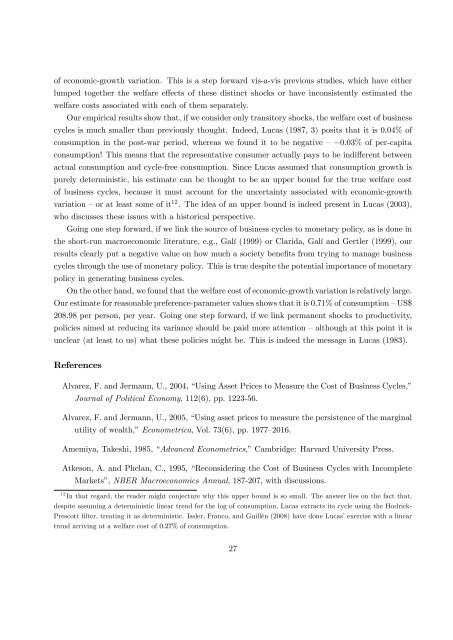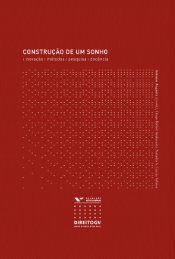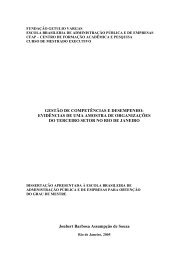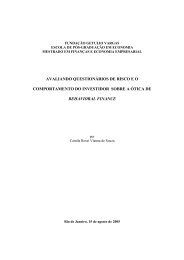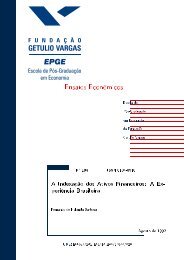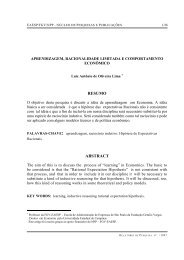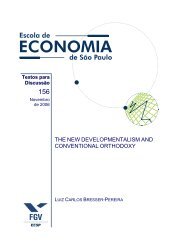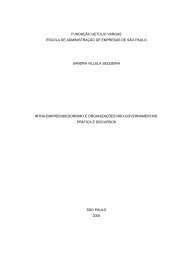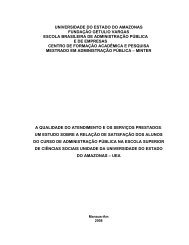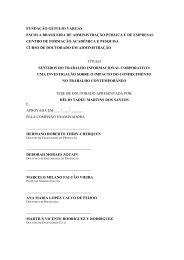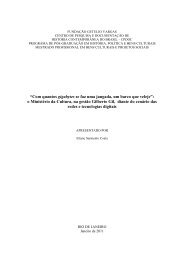Ensaios Econômicos - Sistema de Bibliotecas da FGV - Fundação ...
Ensaios Econômicos - Sistema de Bibliotecas da FGV - Fundação ...
Ensaios Econômicos - Sistema de Bibliotecas da FGV - Fundação ...
You also want an ePaper? Increase the reach of your titles
YUMPU automatically turns print PDFs into web optimized ePapers that Google loves.
of economic-growth variation. This is a step forward vis-a-vis previous studies, which have either<br />
lumped together the welfare e¤ects of these distinct shocks or have inconsistently estimated the<br />
welfare costs associated with each of them separately.<br />
Our empirical results show that, if we consi<strong>de</strong>r only transitory shocks, the welfare cost of business<br />
cycles is much smaller than previously thought. In<strong>de</strong>ed, Lucas (1987, 3) posits that it is 0:04% of<br />
consumption in the post-war period, whereas we found it to be negative – 0:03% of per-capita<br />
consumption! This means that the representative consumer actually pays to be indi¤erent between<br />
actual consumption and cycle-free consumption. Since Lucas assumed that consumption growth is<br />
purely <strong>de</strong>terministic, his estimate can be thought to be an upper bound for the true welfare cost<br />
of business cycles, because it must account for the uncertainty associated with economic-growth<br />
variation –or at least some of it 12 . The i<strong>de</strong>a of an upper bound is in<strong>de</strong>ed present in Lucas (2003),<br />
who discusses these issues with a historical perspective.<br />
Going one step forward, if we link the source of business cycles to monetary policy, as is done in<br />
the short-run macroeconomic literature, e.g., Galí (1999) or Clari<strong>da</strong>, Galí and Gertler (1999), our<br />
results clearly put a negative value on how much a society bene…ts from trying to manage business<br />
cycles through the use of monetary policy. This is true <strong>de</strong>spite the potential importance of monetary<br />
policy in generating business cycles.<br />
On the other hand, we found that the welfare cost of economic-growth variation is relatively large.<br />
Our estimate for reasonable preference-parameter values shows that it is 0:71% of consumption –US$<br />
208:98 per person, per year. Going one step forward, if we link permanent shocks to productivity,<br />
policies aimed at reducing its variance should be paid more attention –although at this point it is<br />
unclear (at least to us) what these policies might be. This is in<strong>de</strong>ed the message in Lucas (1983).<br />
References<br />
Alvarez, F. and Jermann, U., 2004, “Using Asset Prices to Measure the Cost of Business Cycles,”<br />
Journal of Political Economy, 112(6), pp. 1223-56.<br />
Alvarez, F. and Jermann, U., 2005, “Using asset prices to measure the persistence of the marginal<br />
utility of wealth,”Econometrica, Vol. 73(6), pp. 1977–2016.<br />
Amemiya, Takeshi, 1985, “Advanced Econometrics,”Cambridge: Harvard University Press.<br />
Atkeson, A. and Phelan, C., 1995, “Reconsi<strong>de</strong>ring the Cost of Business Cycles with Incomplete<br />
Markets”, NBER Macroeconomics Annual, 187-207, with discussions.<br />
12 In that regard, the rea<strong>de</strong>r might conjecture why this upper bound is so small. The answer lies on the fact that,<br />
<strong>de</strong>spite assuming a <strong>de</strong>terministic linear trend for the log of consumption, Lucas extracts its cycle using the Hodrick-<br />
Prescott …lter, treating it as <strong>de</strong>terministic. Issler, Franco, and Guillén (2008) have done Lucas’exercise with a linear<br />
trend arriving at a welfare cost of 0:27% of consumption.<br />
27


